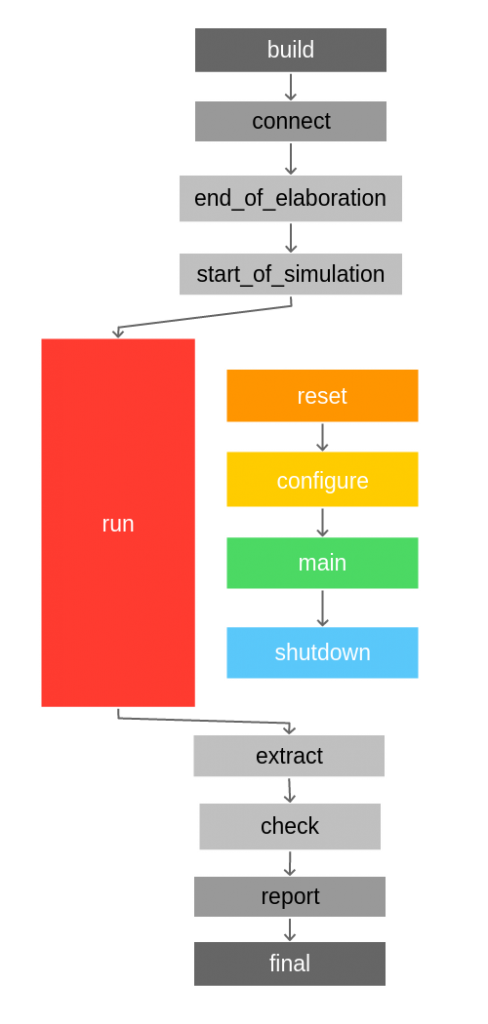UVM introduces the concept of phases to ensure that all objects are properly configured and connected before starting the runtime simulation. Phases contribute to a better synchronised simulation and enable to the verification engineer to get better modularity of the testbench.
UVM phases consists of:
- build
- connect
- end_of_elaboration
- start_of_simulation
- run
- reset
- configure
- main
- shutdown
- extract
- check
- report
- final
The run phase has been simplified to get a better picture of how phases worked. Nevertheless, all subphases in the run phase have a pre_ and post_ phase to add flexibility. Therefore, the run phase is actually composed by the following phases:
- run
- pre_reset
- reset
- post_reset
- pre_configure
- configure
- post_configure
- pre_main
- main
- post_main
- pre_shutdown
- shutdown
- post_shutdown
Although all phases play an important role, the most relevant phases are:
- build_phase: objects are created
- connect_phase: interconnection between objects are hooked
- run_phase: the test starts. The run_phase is the only phase which is a task instead of a function, and therefore is the only one that can consume time in the simulation.
UVM phases are executed from a hierarchical point of view from top to down fashion. This means that the first object that executes a phase is the top object, usually
testbench → test → environment → agent → {monitor, driver, sequencer, etc}
Nevertheless, in the connect phase, this happens the other way round in a down to top fashion.
{monitor, driver, sequencer} → agent → environment → test → testbench

Soy Daniel de Valencia . Me gustaría hablarte de un pequeño proyecto que tengo en mente. Como conectar entre si dos esp8266-01
Uno como cliente con entrada gpio2 de un sensor de lluvia, que manda orden ( cuando llueve) durante 20 segundos al otro esp8266-01 como servidor,
con salida por gpio2 a un relé, que hace que baje la persiana de una ventana.
La idea es meter el esp8266-01 (servidor) dentro de la caja empotrada de los pulsadores de subir/bajar la persiana.
La cuestión es que lo quiero hacer inalámbricamente.
Es posible hacer el proyecto?
He mirado mucho por internet y no he visto nada, podríais echarme una mano
Tengo todo lo necesario para empezar. GRACIAS
Mi problema es, que de programación, NO tengo nada de idea. ¿Tu podrías desarrollar el código (sketch)que hiciera funcionar mi proyecto?
Muchas Gracias por la atención, espero tu ayuda. Un abrazo
dazallu@hotmail.com